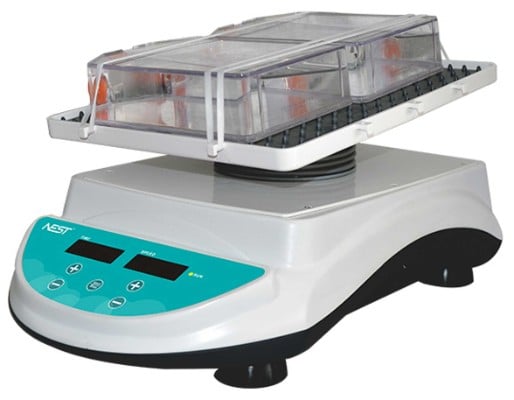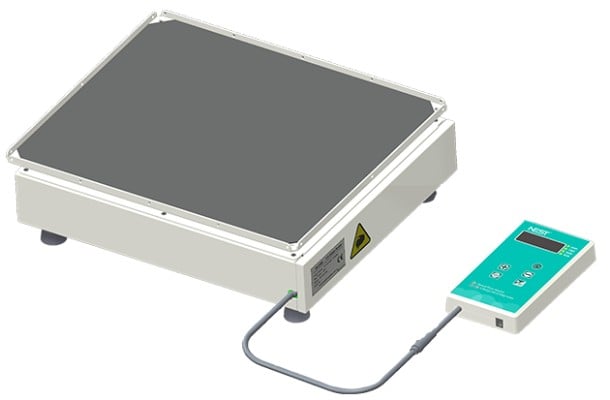Laboratory Shakers: What Are They?
May 4, 2022

Mixing, blending, and agitating solutions are a major part of scientific experimentation. Laboratory shakers do all these, shaking the mixtures placed on them.
This equipment is particularly essential in the fields of chemistry and biology. And with most labs using a greater range of sample sizes than ever before, it is a piece worth considering.
Knowing what laboratory shakers are, their types and their uses will give you the advantage. For one, equipping your lab with the ideal shaker for effective shaking applications.
Laboratory Shakers
A laboratory shaker is a tool often used in various shaking and mixing procedures in the lab. It comprises a motor-powered platform that agitates in horizontal or orbital motion.
This is done by putting a substance in a flask or tube, before placing them onto/into the machine. Then, plates vibrate back and forth or circularly to mix the components.
The shaker’s platform caters to different vessels. Most include features like adjustable shaking speed and precise temperature settings.
Laboratory shakers help to form a homogenous mixture from more than one ingredient. They are used in different industries other than in pharmaceutical, such as:
- Food and beverage
- Cosmetics
- Electronics
They also play a big role in labs that deal with life sciences, wastewater treatment, and biotech.
How Do Laboratory Shakers Work?
A laboratory shaker works by generating a circular shaking motion at a slow speed of 25-500 rpm. It contains a housing with motor and control panels, where a platform is attached.
The platform holds the vessel for blending, agitating, or mixing the substances. It may have simple grooves for supporting flasks and tubes horizontally. Or it may have basket style holders to keep the sample holders upright.
Depending on the application, the shaker platform, shape, and texture can vary. This includes the shaking motion itself.
These factors can also determine the number of flasks or tubes for which the shaker has capacity. Fortunately, you can customise a platform shaker to your needs.
Types of Laboratory Shakers
Versatility is important when it comes to laboratory shakers. Thus, many different kinds of shakers are available on the market.
The two that are most common are:
- Orbital shakers
- Plate shakers
Orbital shakers
An orbital shaker moves in a circular shaking motion at various speeds, with low speeds of 25 up to 800 rpm, hence the name. It does not produce vibrations; instead, it generates low heat, which other shakers do not.
Ideal use for washing bolts, general mixing and culturing microbes. Orbital shakers are primarily used in the fields of biology and chemistry. But they feature in many other applications as well.
This type of lab shaker can be modified by placing it inside an incubator. In return, it creates an incubator shaker with low temperatures and vibrations.
Please have a look at our range of orbital shakers below and see if they meet your lab needs!

1. Nutating Mixer – Orbital Shaker and Rocker
Product code: LQ1552
The Nutating Mixer combines the motions of an orbital shaker and a rocker to mix samples. The result is a thorough yet gentle mixing without foaming.
Continuous or timed operation with auto-shutdown and comes with adjustable speed and timer. A low voltage power supply provides safe cold room operation and low energy consumption.
The gentle and adjustable motion is ideal for a wide range of staining applications. Includes a large platform and non-slip mat.

2. OHAUS Orbital Open Air Shaker 15mm Orbit (SHLD0415AL)
Product code: LQ1530
The OHAUS Orbital Open Air Shaker has a speed range of 40 to 300 rpm with a 15mm orbit. The variable speed microprocessor control provides consistent uniform shaking action.
An economical shaker designed for educational labs or basic shaking applications. Featuring a low profile design, it takes up less space and easily fits into hoods and incubators.
The variable speed microprocessor control provides consistent uniform shaking action. Slowly increases speed to desired set-point to avoid splashing. Basic speed knob with dial settings from 1 to 10.

3. Orbital Shaker CO2
Product code: LQ1550
The CO2 Orbital Shaker is for use in high humidity and CO2 environments. It provides regulated orbital motion of the platform, and you can also use it as a standard shaker.
Its driving mechanism uses magnets and sealed electrical coils. Even better, it is low-maintenance and has a long lifespan.
You can remove the controller from the shaker’s body and use it to control the shaker’s speed remotely.
Plate shakers
Also known as a platform shaker, a plate shaker features a table board. The board oscillates horizontally, allowing beakers and flasks to be set on top.
Liquids can also be put inside small vials or test tubes and nested into holes on the plate. This shaker type is designed to be built in labs.
Plate shakers can also be modified just like orbital shakers. Ideal for combining with other machines, such as a rotating mixer for small systems.
The Benefits
There are benefits to using laboratory shakers, including the following:
- Lab shakers do not cause vibrations on benchtops. Thus, machines and processes in the area are undisturbed.
- They come in a compact design, making them ideal space-saving equipment.
- They can hold a variety of containers, such as test tubes, flasks, beakers and more.
- Most shaker units have maintenance-free brushless DC motors.
- Modern models feature over speed detection and protection.
- Compatible with incubators.
- A remote function that provides PC control and data transmission.
- Some shakers come with anti-slip platforms to secure tubes, flasks or straps.
Top Uses of Laboratory Shakers
On top of general mixing, there are many different uses for a shaker, and these are:
- Bacterial suspensions
- Cell cultures
- Destaining
- Diagnostic testing
- Extraction procedures
- Hybridisation
- Solubility studies
- Staining
- Washing procedures
Factors to Consider When Buying a Laboratory Shaker
As an essential tool inside the lab, it is vital to know the right features and options to fit your needs. Here are the key factors you must consider before purchasing a lab shaker.
- Accessories and options
- Adequate alarm system
- After-sales service
- CO2-resistant option
- Energy-efficiency
- Ergonomic features
- Heavy-duty drive system
- Load capacity
- Maintenance-free and brushless motor
- Multiple interchangeable platforms
- Orbit size
- Ports for easy access
- Precise and wide temperature range
- Programmable and user-friendly control system
- Warranty period
- Wide speed range
- Wide timer range
The Bottom Line
Laboratory shakers are important in labs and different industries. Overall, they are useful in forming a homogeneous mixture from multiple ingredients.
Lab personnel should be trained before operating one. This is to avoid accidents, while at the same time, prolong the lifespan of the device.
The shaker must be installed as described in the user manual. Further, personnel must wear laboratory safety equipment or PPE. This is to ensure safety while working with microbiological cultures and chemicals.
© Electrotech Brands Pty Ltd 2022


Write a Comment
You must be logged in to post a comment.